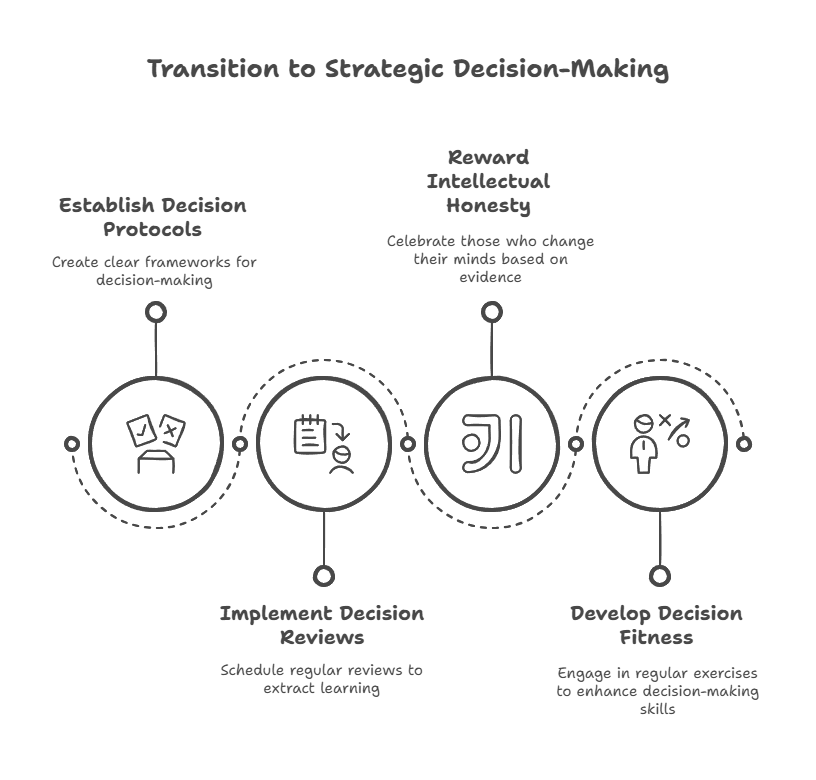What Mike Tyson Knows About Your Strategic Plan That Your Board Doesn’t
Most Business Decisions: A Costly Ego Validation Exercise with Dire Consequences
Let’s have an uncomfortable chat about decision-making – that thing everyone thinks they’re exceptional at until they’re staring at the smouldering ruins of their latest “strategic pivot.
It’s fascinating how the same psychological flaws that lead celebrities to tattoo their faces or politicians to tweet at 3 AM manifest in boardrooms across the world—the cognitive equivalent of watching someone design their dream yacht. At the same time, their current rowboat actively takes on water.
The “I’m Grown“ Syndrome: Corporate Edition
We’ve all encountered the business equivalent of a teenager proclaiming “I’m grown“ – it just comes dressed in fancier language:
“We’re disrupting the industry.”
“We’re taking an unconventional approach.”
“We trust our instincts over market data.”
Translation: “I don’t have to listen to anyone. I know best.“
This delusion persists even as the quarterly numbers perform their sad trombone soundtrack in the background.
The brutal truth? Most business leaders aren’t making decisions – they’re engaging in elaborate confirmation bias rituals, seeking evidence that validates what they already want to do while systematically ignoring red flags the size of Amazon.
The Cost of Cognitive Comfort
As Mike Tyson so eloquently put it:
“Everybody has a plan until they get punched in the face.”
The full version of that quote reportedly continues, “Then, like a rat, they stop in fear and freeze.” This is a brutally accurate description of what happens to most business strategies when they collide with market reality.

Your meticulously crafted five-year plan, elegant slide decks, and confident boardroom presentations are all theoretical constructs until they encounter the Tyson-esque right hook of actual customer behaviour, competitive response, or market shifts.
What’s particularly fascinating is how this phenomenon manifests in the corporate world. Companies spend millions on strategic planning exercises, only to witness complete decision paralysis when the first unexpected challenge appears. Like Tyson’s opponents, they freeze, unable to adapt because they’ve confused having a plan with being prepared.
The quality of your decisions will eventually exceed the quality of your excuses, at which point actual growth begins.”
The business landscape is littered with the corporate corpses of organisations that looked fantastic on paper but lacked the adaptive capacity to roll with the punches. Remember Blockbuster’s opportunity to buy Netflix? Or Kodak’s invention of the digital camera, only to shelve it? These weren’t failures of planning—they were failures of response when market reality delivered its inevitable haymaker.
The price tag for this psychological comfort isn’t just financial – it’s existential. While your team exhausts itself justifying decisions retroactively rather than analysing them prospectively, your competition methodically separates signals from noise.
Two forces eventually intervene in this cycle of business self-delusion:
- Market reality – that cold shower of consequences when your strategy meets actual customers
- Hard-earned wisdom – the expensive education you receive from repeated failures
Unfortunately, many businesses run out of runway before wisdom arrives. The market is remarkably efficient at converting hubris into bankruptcy.
The Strategic Decision Architecture: Beyond “Going With Your Gut“
Let me be clear about something: decision-making isn’t some mystical art where “following your passion“ leads to market dominance. It’s a structured discipline that requires intellectual rigour and emotional discipline.

Here’s the framework I implement with clients who are serious about transformational growth:
1. Define the Problem with Brutal Precision
Most bad decisions begin with poorly framed problems. “How do we increase sales?“ is a terrible question. “Which customer segments offer the highest margin growth potential with our current capabilities?“ focuses the decision architecture toward meaningful outcomes.
The discipline of precise problem definition forces clarity before action, which most organisations find excruciating because it delays the dopamine hit of “doing something.“
My advice is to lead with the forward thinking questions, those that encourage actions and position you strategically for your next moves.
2. Conduct Research as if You’re Wrong
The most valuable Research doesn’t confirm your hypothesis – it challenges it. If you’re not finding evidence that contradicts your initial thinking, you’re not researching; you’re just shopping for validation.
This isn’t about gathering more data (though that helps). It’s about intentionally seeking disconfirming evidence with the same vigour you hunt for supporting facts.
3. Deliberate Consultation, Not Echo Chambers
There’s a world of difference between consultation and consensus. The former seeks diverse perspectives to illuminate blind spots; the latter dilutes responsibility and reinforces groupthink.
You have to be creative here, and to do so, first identify individuals who have:
- Successfully navigated similar decisions
- A track record of being right when everyone else was wrong (a true contrarian with a pint of courage :))
- The courage to tell you what you don’t want to hear (this may be hard to accept, but we are not right 100% of the time. We all have blind spots here and there, let that sink in).
These people rarely sit in your executive meetings because cognitive diversity is culturally uncomfortable.
4. Develop Competing Alternatives (Minimum: Three)
If you evaluate fewer than three genuine alternatives, you’re not making a decision—you’re seeking permission. The discipline of developing multiple viable options forces deeper thinking and prevents premature convergence.
Each alternative should:
- Be genuinely viable (not straw men to make your preferred option look good)
- Address the core problem from fundamentally different angles
- Have its own risk profile and advantage structure
5. Make Decisions Based on Values, Not Convenience
When faced with difficult tradeoffs, most organisations default to expedience rather than what aligns with their stated values. This creates the strategic equivalent of multiple personality disorder, where your actions contradict your declared principles.
I am allergic to short-term thinking and instant gratification. You should delay declaring early wins. Stand for something and protect your beliefs. Integrity rules.
“The true test of values isn’t when they’re easy to uphold – it’s when they’re expensive to maintain.”
6. Move Forward with Clarity and Accountability
Once a decision is made, communicate it with:
- Crystal clarity on the expected outcomes (clearly defined expectations and goals are halfway to effective solutions)
- Specific metrics for success and failure ( you’ll get better with experience, the more you do, accuracy will improve)
- Personal accountability for results (this is essential as you may have great plans and expectations, great processes lined up but if attitude and will are missing, your best intentions and great expectations will fail miserably)
- Explicit timelines for evaluation (chunk it down with laser precision, smaller steps, actions and follow ups and have critical milestones specified so that you can track progress or the lack of it)
The courage to make clear decisions is matched only by the discipline to evaluate them honestly.
The Transformation Bridge: From Reactivity to Strategic Mastery
The shift from reactive to strategic decision-making doesn’t happen overnight. It requires systematic rewiring of your organisational neurons:
- Establish Decision Protocols: Create clear frameworks for different types and magnitudes of decisions.
- Implement Decision Reviews: Schedule regular, non-punitive reviews of major decisions to extract learning.
- Reward Intellectual Honesty: Celebrate those who change their minds when evidence contradicts their initial position. The true indicator of intelligence is when the person (based on new information) reconsiders its original opinions, postion and beliefs.
- Develop Decision Fitness: Just as physical fitness requires regular exercise, decision fitness requires consistent practice with feedback.

Organisations that master this transformation gain an almost unfair advantage – the ability to make consistently better decisions than their competitors across thousands of choice points.
Your Action Plan: Decision Excellence in 30 Days
Week 1: Decision Audit
- Document your three most significant recent decisions
- Analyse the process used for each
- Identify pattern errors in your decision architecture
Week 2: Framework Implementation
- Select a decision framework appropriate to your organisation
- Train key decision-makers in the methodology
- Apply it to one pending decision as a pilot
Week 3: Feedback System Design
- Create mechanisms to capture decision outcomes
- Establish regular decision review sessions
- Develop metrics for decision quality (separate from outcomes)
Week 4: Cultural Reinforcement
- Recognise and reward quality decision processes
- Address organisational barriers to objective decision-making
- Institutionalise decision excellence as a core competency
The Ultimate Competitive Advantage
In a world obsessed with technology, market positioning, and capital efficiency, decision quality remains the most underleveraged competitive advantage. While your competitors chase the latest management fads, build your capacity to consistently make better choices.
As investor Charlie Munger observed:
“It is remarkable how much long-term advantage people like us have gotten by trying to be consistently not stupid, instead of trying to be very intelligent.”
Your strategy isn’t a document – it’s the accumulated impact of thousands of decisions, large and small. Optimise that process, and you transform your organisation from the inside out.
The choice, as always, is yours. Make it a good one.
“In business as in life, you don’t get what you deserve – you get what your decisions create. Choose accordingly.”
Dodd, B. The Top 100 Leadership Quotes Of 2023 Part 2. https://core.ac.uk/download/604528220.pdf


1 Comment
I’m very pleased to discover this great site. I need
to to thank you for ones time for this wonderful read!! I definitely savored every little bit
of it and i also have you bookmarked to see new stuff in your blog.